Murals give someone the opportunity to tell their story.
That's what Joel Bergner, a mural artist, aims to do when he works with Latino youth in the D.C. area to create art.
"We have this process in which we guide the participants, the kids, through this process of creating their mirror," he said. "When you see that mural, you're actually seeing all of their expressions, you're seeing their stories, you're seeing everything that's important to them through that mural."
"Public art has the power to provide that platform," Bergner said.
Photos: More Murals by Joel Bergner
Hola Cultura, a D.C. non-profit created to celebrate the diversity of Latino culture, jumpstarted a research project about Latino murals in the city.
The organization says that D.C. is "home to a thriving Latino mural-making tradition" but discovered however many of those murals have disappeared.
In an interactive map, Hola Cultura takes viewers through the history of murals that have disappeared and those that still exist.
"That whole world of public art, like it's ephemeral by nature," Bergner said.
"They're not going to last forever. So that's something you know going into it," he said about his work as a muralist.
However, the public can support more of these murals by supporting organizations that sponsor this art or simply sharing the love on social media, Bergner said.
"A lot of these murals have a big public celebration that you can attend and really show your support for these kinds of projects," Bergner said.
Here are some Latino murals in D.C. that visitors and residents can still enjoy.
Un Pueblo Sin Murales Es Un Pueblo Desmuralizado
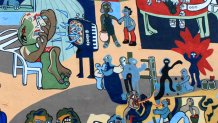
The mural "Un Pueblo Sin Murales Es Un Pueblo Desmuralizado" translates to "A People Without Murals Is a Demuralized People." This artwork, created in the 1970s and located in Adams Morgan, is the oldest Latino street mural visible in D.C.
The mural was first painted by Carlos "Caco" Salazar with the help of the community, and it has been restored twice by Juan Pineda. Its most recent restoration was in 2014.
In the "Muralism DC" documentary, Enrique "Quique" Aviles, a poet and artist, explains that most of the Latino murals in Adams Morgan disappeared in the 1980s as the area was gentrified.
"It tells the history of the neighborhood," Aviles said about the mural in the documentary.
Nueva Vida (New Life)
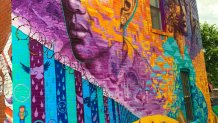
Bergner created this mural near the Howard Theatre in collaboration with 15 children and teens from Central America who are now living in the D.C. area. It was sponsored by the Kids in Need of Defense (KIND), which provides legal services to immigrant children, in collaboration with Bergner's non-profit, Artolution.
Bergner said these children came to the U.S. seeking asylum after fleeing conflict, violence and in some cases sex trafficking.
"This is a huge political topic. It's a huge news story, but you hardly ever get to really experience like the humanity of the people who are actually affected," Bergner said.
This mural allowed the teenagers to present their stories to the community.
"I'm not just about one thing. I have so many different elements of who I am, and I want to share all of that with the world," is what participants said in the artwork, Bergner said.
Visitors can find the mural at 600 T Street NW D.C.
Currulao y Desplazamiento: The Afro-Colombian Mural
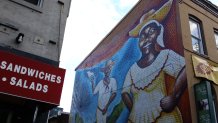
"Currulao y Desplazamiento" on U Street is a mural dedicated to people displaced in Colombia's civil conflict. It was painted in 2009 by Bergner with the support of the DC Commission on the Arts and Humanities.
The mural was designed by local Afro-Colombians from the Pacific coast of Colombia who sought asylum in the U.S. due to ongoing armed conflicts in their home country.
"I supported them through this process of creating a mural that told their story, both celebrating their culture and also informing people about what the situation is in their communities in Colombia," Bergner said.
Felipe's Story
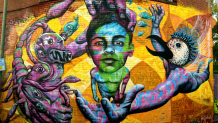
This mural located in Columbia Heights features Felipe, a boy growing up in a Rio de Janeiro favela, a type of Brazilian slum, called City of God.
Bergner met Felipe while he was spending time in Brazil and saw him grow from an 11-year-old child to a man in his early 20s.
"I kind of saw how he developed over the years and the kind of the different struggles that he faced being from a community where there is an amazing culture and really, really incredible people and also a lot of challenges in terms of just a failure of the state to really invest in the community," Bergner said.
These struggles are depicted in the mural.
"There are two creatures struggling over him; one a demon and the other a winged bird-man who wants to guide Felipe in the right direction. As they battle to influence him, Felipe stands still, trying to figure out which way to go and what to do with his life," Bergner wrote on his website.
Columbia Heights Es/Is
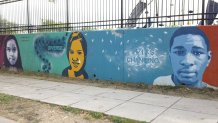
This mural was created by the Latin American Youth Center (LAYC) with instructors Tim Gibbons and Sam Williams. It runs along the side of Tubman Elementary School in Columbia Heights.
LAYC is an organization that offers bilingual programs and services designed to "address many of the barriers to success low-income youth face" in D.C., Prince George's County and Montgomery County in Maryland.
The organization has collaborated in various mural projects since its inception in the late 1960s — some of which have since disappeared.

